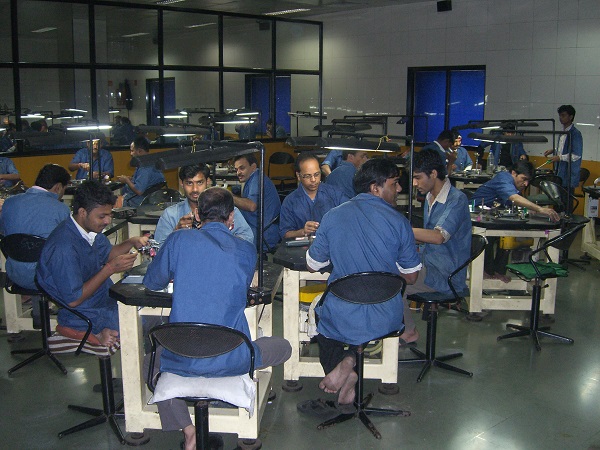|
|
Diamond Cutters Approaching Era of Disruption
Competition Likely to Intensify
Dec 14, 2014 4:04 AM
By Ronen Shnidman
|
|
|
RAPAPORT... Diamond manufacturers are entering an era of fierce competition as the looming decline in rough diamond supply is expected to place additional pressure on their already razor-thin profit margins.
“A manufacturer always operates with a benchmark margin, which is the minimum he needs to make a reasonable return on equity,” explains Vishal Doshi, the executive director of the manufacturer Shrenuj & Co. “In spite of all the efficiencies, we have reached the border between the business being either sustainable or unsustainable.”
Some manufacturers are already adapting their business models to cope with this problem, in ways that industry observers believe will alter how the entire diamond pipeline operates in the coming years.
Differentiate or Disappear
However, Dinesh Navadiya, the president of the Surat Diamond Association (SDA), notes that manufacturers have limited options to cut costs and improve margins. While they tend to expand their labor force when rough supplies grow, cutters avoid retrenchments when the profits run dry, he explains.
“Employers never lay off workers,” Navadiya says. “There is a scarcity of artisans in the industry so the question of layoffs does not arise.”
Even during the 2008 financial crisis, factory owners in Surat tried to avoid layoffs, preferring to retain their workers by instituting temporary salary cuts.
 Navadiya further dismisses the likelihood that factory owners will increase profits by absorbing smaller or weaker companies to reduce competition. He states that no notable consolidations have occurred in Surat in recent years and that he does not expect significant consolidation to occur in the future. Navadiya further dismisses the likelihood that factory owners will increase profits by absorbing smaller or weaker companies to reduce competition. He states that no notable consolidations have occurred in Surat in recent years and that he does not expect significant consolidation to occur in the future.
Consequently, the only way that manufacturers will be able to contend with tightening profit margins is through product differentiation and factory closures, concludes Mike Aggett, the managing director of H. Goldie & Company, a De Beers accredited broker.
Aggett notes that the diamond manufacturing sector is undergoing some consolidation, but this is occurring at a slow pace and largely through companies exiting the industry. He attributes this to the fact that the industry is predominantly made up of family-run businesses that find consolidation more difficult than would purely corporate entities.
“Certainly in India a number of smaller operations have disappeared,” he says. “It will be a slow, ongoing process but the less sustainable businesses will disappear.”
Aggett stresses that manufacturers who wish to remain in the industry will have to focus their efforts on design and branding as a means to improve their profit margins. Consumers are becoming increasingly price conscious, and the only way to make price secondary in their buying decisions is by presenting them with a differentiated product, he explains.
Emanuel Namdar, the general manager of S.N. Asia, a diamond manufacturer, agrees with Aggett and adds that branding is essential because the jewelry marketplace is already crowded and intensely competitive even in emerging markets.
“When you head out to the Far East and pass the jewelry displays on the street, you can see that every consumer interested in buying a diamond ring has hundreds to choose from within a 10-minute walk,” Namdar says. “You must add value through branding. Otherwise, the competition at the consumer level is too fierce.”
Doshi notes that many diamond manufacturers are integrating downstream to achieve that added value and differentiate their product and services.
“The more you can sell diamonds in jewelry, the more your gross margins will go up,” he explained in an interview with Rapaport News earlier this year. “But not everyone can execute it because it’s a different business with a different mindset and a different business model.”
Declining Rough Supply
Most manufacturers who spoke with Rapaport News agreed that manufacturing rough into polished alone is not sufficient to cope with high rough prices and the further forecasted increases.
According to industry consultants at Bain & Company, diamond prices are expected to rise in the long term as supply is forecast to decline from 2018 onward, while demand continues to grow.

De Beers expects that global rough diamond supply will peak at slightly over 160 million carats in 2018 but will plummet to 120 million carats around 2025. This constitutes a 25 percent drop from peak production in less than a decade. De Beers estimates that approximately 146 million carats were recovered in 2013.
De Beers attributes this drop in production to a lack of new mining projects expected to come on stream after 2025 that have potential production volume large enough to impact the overall market. Even if new, large mines are discovered, De Beers noted in its recently published Diamond Insight Report that these would not be developed fast enough to prevent the contraction in supply. The company estimates that the latest generation of large diamond mines have taken on average 22 years to reach production from their initial discovery.
Rough Financing Impacting Pipeline
Bain expects that the demand-supply gap will further squeeze manufacturers’ profit margins at a time when it is becoming increasingly difficult to obtain financing for the working capital needed to reap efficiency gains.
Des Kilalea, a diamond mining analyst for RBC Capital Markets, suggests that it is this lack of financing for rough purchases that will be the final nail in the coffin for smaller, family-owned manufacturing operations.
Kilalea cautions that the entire diamond pipeline has entered an unhealthy situation whereby manufacturers are financing the profitability of the miners and retailers with their bank credit. He predicts that the diamond pipeline will address the problem by evolving toward simpler supply lines with fewer, larger players.
“The longer-term issue is that the miners are not really going to be able to dictate any price to the market because the banks aren't going to continue financing it,” he says. “Manufacturers will [then] become more reticent to pay high rough prices [in cash] and they will stop extending such crazy credit terms to their own buyers. Why should the guy in the middle be the bankers for the guys on the ends?”
Kilalea expects that the larger manufacturers will address the finance issue by increasingly raising funding from the stock and bond markets to finance their working capital.
Moreover, Kilalea forecasts that as banks reduce their credit lines for rough purchases, the mining and retail segments will be forced to ensure that their profits are not affected if manufacturers go bankrupt.
“The big retailers with financial muscle want to secure the rough and ensure that there are no financial interruptions,” Kilalea says. He explains that retailers are worried that their diamond suppliers may go bankrupt and leave them in the lurch without merchandise. Moreover, the retailers have an easier time of financing their working capital, often paying lower interest rates than their own suppliers.
As a result, Kilalea expects that more large-scale retailers will pursue arrangements similar to those of Tiffany & Co. The New York-based retailer has its own polishing division that procures rough through sight contracts with De Beers and ALROSA and also holds off-take agreements with junior miners Kimberley Diamonds and DiamondCorp to fulfill some of its specific rough requirements.
Bain said in its 2013 industry report that the trend of retailers integrating upstream along the diamond value chain is likely to continue, creating additional pressure on manufacturers as retailers compete for rough with their own polished suppliers.
Survival Not Guaranteed
The consulting company therefore expects further consolidation and integration in the middle of the diamond pipeline as manufacturers seek to maximize their profit margins through efficiencies of scale and scope.
Some manufacturers already predict that there will be consolidation in the cutting and polishing industry even if polished prices rise in the coming decade.
Namdar expects that polished prices will rise significantly in the next decade but diamantaires will need to continually find ways to add value along the pipeline in order to survive and benefit from these higher prices.
“There will be an industry and people will work hard because the ones that won’t work hard won’t be around in 10 years’ time,” he says. “I can’t even guarantee that I will be there, but I know that many good companies that are here today have a roadmap to get there.”
|
|
|
|
|
|
|
|
|
|
Tags:
bain, De Beers, Doshi, Insight Report, Namdar, Polishing, Ronen Shnidman, Rough diamond prices, rough diamond supply, Shrenuj, SN-Asia
|
|
|
|
|
|
|
|
|
|
|

|
|